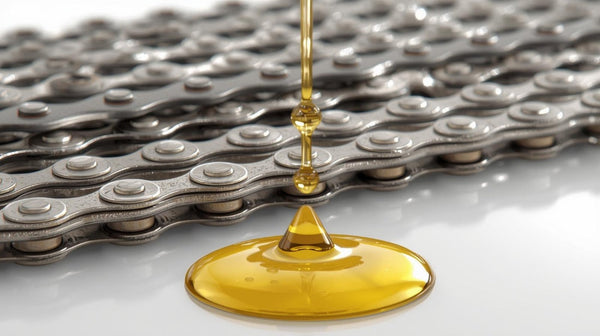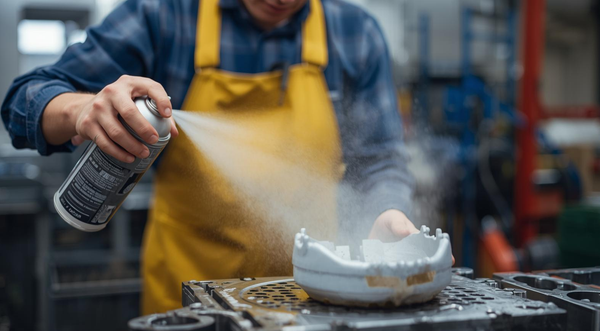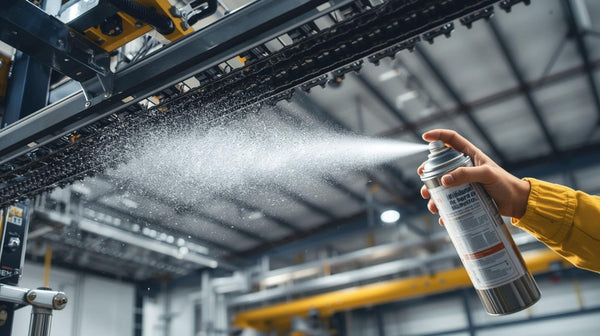Introduction
Elastomeric machine parts and components can be a cost-effective alternative to metal components, and proper lubrication can extend their life and performance. However, some traditional lubricant formulations are not compatible with elastomers and can weaken or degrade the part, making testing critical to determining the right lubricant for the application. Compatibility charts exist, but they are general starting guidelines and are not complete.

"Compatibility" in this regard is when the grease or other lubricant has minimal effect on the physical properties of the polymer or elastomer in terms of size, hardness, or brittleness. The acceptability of changes in the polymer and grease depends on the application in which they are to be used. Application of the test method described in this article will facilitate selection and help users identify viable and non-viable grease options by calculating swelling and observing changes in color and/or texture.
The figure shows an example of EPDM O-ring inspection compared to the O-ring test after treatment (82% swelling)

Rubber Compatibility Test
Research methods
Examples of test methods for assessing the compatibility of elastomers and polymers under various conditions are presented in the table.
Standardized Test Methods for Compatibility of Polymer/Elastomeric Materials
| Standardized method | Properties assessed |
| ASTM D4289 | Lubrication Compatibility with Elastomer: Greases and Fluids |
| ASTM D471, ASTMD543, ISO 175 | The Effect of Liquid Chemicals on Polymer Materials |
| ASTM E831 | Thermal expansion of solid materials |
| ASTM D7264, ASTMD790, ISO 178 | Bending properties of polymer materials |
| ASTM D638, ISO 527 | Measurement of tensile properties |
ASTM D4289 explains a method for comparing the effects of lubricants on elastomers using sheet materials to evaluate swelling and hardness. This article describes a simplified example of an elastomer compatibility test using O-rings and ignoring hardness. The O-rings were selected for their surface consistency; hardness was omitted because previous experiments showed a direct correlation between swelling and hardness change (swelling/softening vs. shrinkage/hardening).
Note: This method is recommended to be used as a first pass screening test and is not intended to guarantee elastomer/lubricant compatibility under all exposure conditions.
Procedure
Figure Balance equipped with a density determination kit

- Using an analytical balance equipped with a density determination kit and recorded to an accuracy of 0.0001 g, the weights of the O-rings are measured before immersion in the lubricant.
- A thick layer of the chosen lubricant is spread along the aluminum foil.
- Selected O-rings are placed in grease, with plenty of space between O-rings and only 1 type of elastomer per sheet of film.
- To hold the O-rings in place, each elastomer O-ring is gently pressed into the grease.
- A second thick coat is then applied to the O-rings, making sure they are completely covered and that there are no air bubbles in the grease.
- Each aluminum foil test sample is placed on a tray and placed in an oven at 125°C.
- After 3 days (72 hours) at 125°C the grease packages are removed from the oven
- After allowing the material to cool for 15 minutes, the elastomers are removed and wiped with a dry, clean cloth.
- After a second wipe with a clean cloth, the O-rings are reweighed.
- The determination of the volumetric swelling (ΔV%) is calculated:

where: ΔV = volume change, %
M1 = initial mass of the sample in air, g
M2 = initial mass of the sample in water, g
M3 = mass of the sample in air after immersion, g
M4 = mass of the sample in water after immersion, g - Inspect or measure the changes in length and make a determination based on the table below:

Conclusions
Elastomeric machine parts and components can be a cost-effective alternative to metal components, and proper lubrication can extend the life and performance of these components. However, some traditional lubricants are not compatible with plastics and can weaken or degrade the part – so testing is critical to determining the right lubricant for the application.
Applying the test method described in this article can facilitate the selection process and can help users identify viable and non-viable lubricant options by calculating swelling and observing changes in color and/or texture.
This article is based on a publication by Dr. Cassie J. Fhaner, MOLYKOTE® Specialty Lubricants Researcher, and William Fick, Applications Engineer, DuPont.
Compatible greases for lubricating rubber and elastomers are described in an earlier article. Which greases are best for lubricating rubber

Molykote 55 O-ring pneumatic grease for o-ring seals

Molykote 111 silicone compound
Molykote Separator Spray Food Grade Silicone Oil NSF H1 - 400 ml
Food grade silicone oil in Aerosol used as a release agent.
Applications and use
Release agent in the production of rubber and plastic products, cardboard packaging.
MOLYKOTE® G-4500 FM with PTFE
White multi-purpose synthetic food grade grease compatible with rubber and elastomers
Thickened with an aluminum complex, it uses white solids and PTFE as solid lubricants. It is also H1 certified by the NSF for incidental food contact.
WEICON PTFE Spray Dry Teflon Grease
Dry lubricant, excellent sliding properties
"WEICON PTFE-Spray is an oil-free, dry lubricant based on PTFE with excellent sliding properties. It adheres to all metal, wood and rubber surfaces. The high content
PTFE reduces the coefficient of friction, and the grease coating itself does not absorb dust, dirt or water, and is resistant to grease, oils and many chemicals.
MOLYKOTE® 3451 Chemically Resistant Grease Compatible with Rubber and Elastomer
Chemically resistant fluorosilicone grease, PTFE thickened grease, suitable for lubricating rubber.
Krytox GPL 205 Fluorine Non-flammable grease
High quality non-flammable grease approved for contact with oxygen, white, clean, non-toxic, non-reactive. Compatible with rubber.
Fluorine grease based on perfluoropolyether PFPE, does not contain additives and can be used on elements in contact with chemicals. Used for lubrication of seals and O-rings in the aviation industry.
Molykote HP-300 Extreme Condition PFPE Grease - 500g
Fully fluorinated grease provides exceptional performance under extreme conditions. PFPE based grease with a base oil viscosity of 160 cSt at 40 C, uses PTFE as the solid lubricant.
Widely used in harsh environments such as low or high temperatures, corrosive, solvent, liquefied natural gas, high vacuum, etc. It can be used in clean room equipment and semiconductor manufacturing equipment where volatilization of lubricant material is undesirable including rubber and elastomeric seals.















